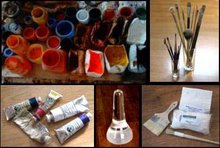Tinting Your Ground
If you like to paint on a tinted ground, the shade used is entirely up to you, but I have learned that it is hard to go wrong by using an earth tone that is complementary to the dominant colour in your painting. (E.g. - if the dominant colour is going to be red, then use a greenish earth tone; if the dominant colours will be cool, use a reddish earth tone... you get the picture).
Cennini's Pigment Suggestions
Some nice hints on coloured grounds can be found in Cennino Cennini's 'Il Libro dell' Arte' (The Craftsman's handbook). For example, in the chapter that deals with tinting paper, he includes a good verdacchio recipe as follows:
"You will make a greenish gray, or drab, in this manner. First take a quarter of an ounce of coarse white lead; the size of a bean of light ocher; less than half a bean of black. Grind these things well together in the regular way."Or, to achieve a warmer fleshy tint, he suggests:
"half an ounce of coarse white lead; and less than a bean of vermilion. And you should grind everything together; and temper in the regular way described above."
Alternative Pigment Suggestions
To achieve a Verdacchio shade that is just a little warmer than Cennini's greenish-grey, try mixing the following pigments together:
3 parts flake white
¼ part vine black
8 parts yellow ochre
½ part burnt sienna
Applying the Tint
Whatever mix you choose, the pigments should be ground in either water or oil, according to whether you are using egg tempera or oils. When preparing a panel for egg tempera, you can mix the water-ground pigments into a solution of rabbit skin glue, and apply this tinted size over your transferred underdrawing as a final tint and size in one. For oils, you can just paint the ground coat on using thinned down oil paint as usual. But in either case, you should be able to see your line drawing through the base coat.
This picture shows a panel tinted for egg tempera... this colour mix is based on the alternative (warmer) verdacchio suggested above, though a little heavy on the yellow ochre.

This picture shows a panel tinted for oils... in this case I have just used a thin coat of raw umber.

Note that these tints can be used just as well on canvas, it is just that my examples on here relate to panels.

No comments:
Post a Comment